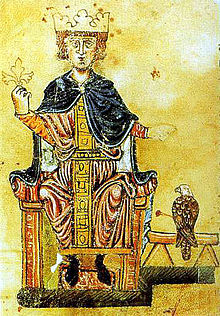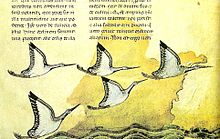- De arte venandi cum avibus
-
De Arte Venandi cum Avibus, literally "The Art of Hunting with Birds", is a Latin treatise on ornithology and Falconry written in the 1240s by Frederick II, and dedicated to his son Manfred.
Frederick II was familiar with Aristotle's treatise on animals in Latin translation :Liber Animalum, a translation from the Arabic by Michael Scotus his court astrologer. He was also familiar with De Scientia Venandi per Aves, a treatise by the Arab falconer Moamyn, it was translated into Latin at his court by Master Theodore of Antioch, and much copied.
It is notable that Frederick II mainly confides in his own observations and experiments: he experimented with eggs to see if they would hatch only by the warmth of the sun; he tried to find out if birds used their sense of smell while hunting by covering the eyes of vultures. The author keeps to his intention, formulated in the preface, to describe the things as they are (“que sunt, sicut sunt”). It is a scientific book, approaching the subject from Aristotle, whom he likes to contradict. At the same time it is a scholastic book, minute and almost mechanical in its divisions and subdivisions.[1]
The original manuscript of Frederick II was lost in 1248 at the siege of Parma. Manuscripts of De arte venandi cum avibus exist in a two-book version (Manuscripts at Rome, Vienna, Paris (2x), Geneva and Stuttgart) and in a six-book version (Manuscripts at Bologna, Paris, Nantes, Valencia, Rennes, and Oxford).[2]
The most famous copy of this treatise is an illuminated manuscript commissioned by his son Manfred, a two-column parchment codex of 111 folios now in the Vatican Library in the Bibliotheca Palatina[3] The manuscript belongs to the two book version and is illustrated with brilliantly coloured, extraordinarily lifelike, accurate and minute images of birds, their attendants, and the instruments of the art. This manuscript contains additions made by Manfred, which are all clearly marked in the beginning by notations such as "Rex", "Rex Manfredus" or "addidit Rex".[4]
The first translation of this work was in French and commissioned around 1300 by Jean II, lord of Dampierre.,[5] and the first translation into English (of the six-book version) was by Casey A. Wood and F. Marjorie Fyfe, as The Art of Falconry by Frederick II of Hohenstaufen (Stanford University Press) 1943. The first printed edition of the Latin manuscript (the two-book version) was by Velser, Augsburg, 1596.
Contents
Books
- The Art of Falconry ISBN 978-4-87187-310-9 ISBN 978-4-87187-311-6
Notes
- ^ Haskins,C.H, The Latin Litarature of Sport (Speculum.) Vol. 2, No 3 (Jul.,1927), PP. 235-252.
- ^ Noted by Wood and Fyfe, 1943, p. lvii
- ^ Vatican, MS. Pal. Lat. 1071. Parchment, 111 folios, 360 x 250 mm.
- ^ Haskins,C.H, The "De Arte Venandi cum Avibus" of the Emperor Frederick II. (the Englisch Historical Review.) Vol.36, No 143 (Jul.,1921), PP. 337 - 339.
- ^ R.W.Corrie, Speculum,Vol. 74, No. 2 (apr. 1999) pp. 414-417.
References
- De Arte Venandi cum Avibus, Bibliotheca Vaticana, Pal. lat. 1071.
- Haskins,C.H, The "De Arte Venandi cum Avibus" of the Emperor Frederick II. (the Englisch Historical Review.) Vol.36, No 143 (Jul.,1921), PP. 334 – 355.
External links
- De arte venandi cum avibus, Scribd (Latin)
- Preface (Latin)
Categories:- Scientific illuminated manuscripts
- 13th-century books
- Vatican Library
Wikimedia Foundation. 2010.


